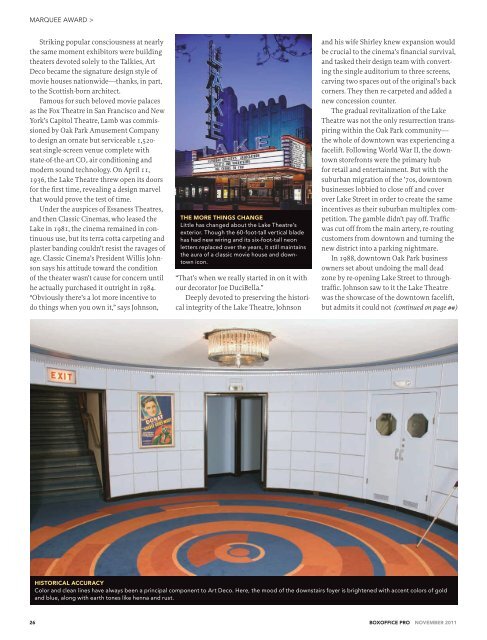You also want an ePaper? Increase the reach of your titles
YUMPU automatically turns print PDFs into web optimized ePapers that Google loves.
MARQUEE AWARD ><br />
Striking popular consciousness at nearly<br />
the same moment exhibitors were building<br />
theaters devoted solely to the Talkies, Art<br />
Deco became the signature design style of<br />
movie houses nationwide—thanks, in part,<br />
to the Scottish-born architect.<br />
Famous for such beloved movie palaces<br />
as the Fox Theatre in San Francisco and New<br />
York’s Capitol Theatre, Lamb was commissioned<br />
by Oak Park Amusement Company<br />
to design an ornate but serviceable 1,520-<br />
seat single-screen venue complete with<br />
state-of-the-art CO 2 air conditioning and<br />
modern sound technology. On April 11,<br />
1936, the Lake Theatre threw open its doors<br />
for the first time, revealing a design marvel<br />
that would prove the test of time.<br />
Under the auspices of Essaness Theatres,<br />
and then Classic Cinemas, who leased the<br />
Lake in 1981, the cinema remained in continuous<br />
use, but its terra cotta carpeting and<br />
plaster banding couldn’t resist the ravages of<br />
age. Classic Cinema’s President Willis Johnson<br />
says his attitude toward the condition<br />
of the theater wasn’t cause for concern until<br />
he actually purchased it outright in 1984.<br />
“Obviously there’s a lot more incentive to<br />
do things when you own it,” says Johnson,<br />
THE MORE THINGS CHANGE<br />
Little has changed about the Lake Theatre’s<br />
exterior. Though the 60-foot-tall vertical blade<br />
has had new wiring and its six-foot-tall neon<br />
letters replaced over the years, it still maintains<br />
the aura of a classic movie house and downtown<br />
icon.<br />
“That’s when we really started in on it with<br />
our decorator Joe DuciBella.”<br />
Deeply devoted to preserving the historical<br />
integrity of the Lake Theatre, Johnson<br />
and his wife Shirley knew expansion would<br />
be crucial to the cinema’s financial survival,<br />
and tasked their design team with converting<br />
the single auditorium to three screens,<br />
carving two spaces out of the original’s back<br />
corners. They then re-carpeted and added a<br />
new concession counter.<br />
The gradual revitalization of the Lake<br />
Theatre was not the only resurrection transpiring<br />
within the Oak Park community—<br />
the whole of downtown was experiencing a<br />
facelift. Following World War II, the downtown<br />
storefronts were the primary hub<br />
for retail and entertainment. But with the<br />
suburban migration of the ’70s, downtown<br />
businesses lobbied to close off and cover<br />
over Lake Street in order to create the same<br />
incentives as their suburban multiplex competition.<br />
The gamble didn’t pay off. Traffic<br />
was cut off from the main artery, re-routing<br />
customers from downtown and turning the<br />
new district into a parking nightmare.<br />
In 1988, downtown Oak Park business<br />
owners set about undoing the mall dead<br />
zone by re-opening Lake Street to throughtraffic.<br />
Johnson saw to it the Lake Theatre<br />
was the showcase of the downtown facelift,<br />
but admits it could not (continued on page ##)<br />
HISTORICAL ACCURACY<br />
Color and clean lines have always been a principal component to Art Deco. Here, the mood of the downstairs foyer is brightened with accent colors of gold<br />
and blue, along with earth tones like henna and rust.<br />
26 BOXOFFICE PRO NOVEMBER <strong>2011</strong>

















